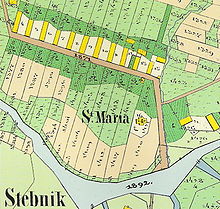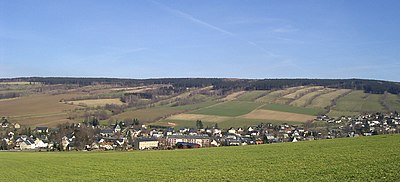Waldhufendorf
The Waldhufendorf is a rural type of settlement that typically occurs in cleared areas and is characterized by a regular floor plan. These are relatively wide strips of agricultural land opposite one another in a row ( Reihendorf ), with the courtyard on the roadside edge of the respective strip.
distribution

Waldhufen and Hagenhufendörfer are particularly in the Vogtland , in the Ore Mountains and its foothills, in Upper Lusatia , in the Sudeten and Beskids , in the Thuringian Forest , in the Fichtel Mountains , in the Bavarian Forest , in the Bohemian Forest , in the Spessart , in the Odenwald , in the Westrich , in the Northern Black Forest as well as in Northern Pomerania .
For example, chained forest hoof villages stretch up to 25 km in the valleys in the Saxon foothills. The core of a Waldhufendorf village can also be seen in villages in other German low mountain ranges.
history
Zotzenbach in the Hessian Odenwald , which was first mentioned in a document in 877, is believed to be the oldest forest hoof village in Germany .
This type of settlement is characteristic of the planned settlement of the northern Black Forest in the 11th and 12th centuries. In the most fertile higher crests of the upper red sandstone were farms (also called " hooves called" or "strokes") along a road through clearance created. A parcel of 24.2 hectares is called “Franconian Hufe”, with elongated plots of land extending roughly at right angles to the central axis to the forest remaining on the ridge behind the buildings . These structures can still be seen today. New research calls into question whether these were planned start-ups. Possibly there were older forms of settlement that consisted more of isolated single farm settlements. Similar observations could be made in row settlements in Saxony.
In the 12th and 13th centuries, the shape of the forest homestead village was also in Thuringia , Saxony and Silesia area the preferred form of settlement of German settlers during colonization . These settlements were also called Hagenhufendörfer because of the land that was mostly surrounded by a hedge ( Hag ) .
to form

In addition to the road, the central axis of the settlement usually also forms a watercourse, on the banks of which there was communal pastureland . New settlers were also given strips of land the size of a hoof, which they cleared, along paths or roads. The courtyards were built along the way, almost always outside the floodplain of the watercourse. Arable farming was practiced on the area behind. At the end of the hooves, forest or forest remnants were often still preserved, which were "worked up" over time when new arable land was needed.
The long parcel boundaries, mostly up the mountain slopes in the low mountain range and its foothills , often reached to the ridge of the ridges and were designed either as paths or as stone ridges . Beyond the ridges, the Waldhufendorf, which is often in the neighboring valley, joined with its corridors .
A rare example of a round forest hoof village is Kreuzberg (Freyung) . Also Gaugenwald and Steinbuch (Michelstadt) (semicircular) may be mentioned in this context.
See also
- List of forest hoof villages
- Waldhufen , municipality in East Saxony
literature
- Rainer Krüger: Typology of the forest hoof village according to individual forms and their distribution patterns. Göttingen 1967 (Göttingen geographical treatises, volume 42).
- Johannes Langer: Local history forays through fields and places of the Ore Mountains and its foreland. Schwarzenberg (Saxony) 1931.
Individual evidence
- ^ Alan Mayhew: Rural settlement and farming in Germany (Batsford Historical Geography Series). Batsford, London 1973, ISBN 0-7134-2105-3 , pp. 69 f.
- ^ R. Schreg: Würzbach - a forest hoof village in the northern Black Forest. In: City - Country - Castle. Festschrift for Sabine Felgenhauer-Schmiedt (Studia honoraria 34). Leidorf, Rahden / Westf. 2013, ISBN 978-3-89646-553-5 , pp. 189-202.
